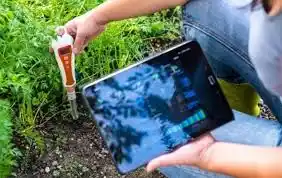The Transformative Role of Technology in Sustainable Agriculture

As the global population continues to grow, the need for sustainable agriculture practices becomes increasingly crucial.
The integration of technology in agriculture has proven to be a game-changer, addressing the challenges faced by farmers and enabling them to adopt more sustainable and efficient practices.
In this article, we will explore the significant role technology plays in promoting sustainable agriculture and how it is revolutionizing the industry.
Precision Agriculture
Precision agriculture is a modern farming approach that utilizes technology to optimize crop production while minimizing resource use.
By employing various tools such as GPS, sensors, and drones, farmers can precisely monitor and manage their crops.
This technology allows farmers to identify areas that require specific attention, such as irrigation or pest control, resulting in reduced water and chemical usage.
Additionally, precision agriculture enables farmers to make data-driven decisions, leading to increased yields and reduced environmental impact.
Smart Irrigation Systems
Water scarcity is a significant concern in agriculture, making efficient water management crucial. Smart irrigation systems employ sensors and weather data to determine the precise water requirements of crops.
By avoiding over-irrigation, these systems conserve water and reduce energy consumption. Moreover, these systems can be remotely controlled, allowing farmers to monitor and adjust irrigation schedules according to real-time conditions.
This technology not only enhances crop productivity but also conserves water resources, contributing to sustainable farming practices.
Crop Monitoring and Disease Detection
Early detection and management of crop diseases are essential for preventing yield losses and reducing the reliance on chemical treatments.
Technology plays a vital role in this aspect by providing farmers with advanced tools for crop monitoring and disease detection.
Remote sensing techniques, such as satellite imagery and drones, enable farmers to monitor crop health and identify potential issues.
Additionally, artificial intelligence algorithms can analyze data to detect disease symptoms and provide proactive recommendations for treatment.
By leveraging these technologies, farmers can take timely action, curbing the spread of diseases and minimizing the need for harmful chemicals.
Vertical Farming and Controlled Environment Agriculture
With the world’s population increasing, the demand for food is rising rapidly. Vertical farming and controlled environment agriculture (CEA) offer sustainable solutions to address this challenge.
These technologies involve growing crops in vertically stacked layers or enclosed environments, such as greenhouses or indoor facilities.
By controlling factors such as temperature, light, and nutrient levels, farmers can optimize crop growth and minimize resource usage.
Vertical farming and CEA systems also reduce the need for land, conserve water, and eliminate the use of pesticides or herbicides.
These techniques are revolutionizing the way we produce food, allowing for year-round cultivation and reducing the environmental impact of traditional farming methods.
FAQs
How does technology benefit sustainable agriculture?
Technology benefits sustainable agriculture by enabling precision farming practices, efficient water management, early disease detection, and controlled environment techniques. These advancements optimize resource utilization, increase productivity, and reduce environmental impact.
Can technology help reduce water usage in agriculture?
Yes, technology plays a crucial role in reducing water usage in agriculture. Smart irrigation systems employ sensors and weather data to determine crop water requirements accurately, resulting in efficient water management and conservation.
How does technology contribute to crop monitoring and disease detection?
Technology enables farmers to monitor crops remotely using satellite imagery, drones, and sensors. Artificial intelligence algorithms analyze the collected data to detect disease symptoms early on, facilitating proactive management and reducing dependence on harmful chemicals.
What are the advantages of vertical farming and controlled environment agriculture?
Vertical farming and controlled environment agriculture offer several advantages, including year-round cultivation, higher crop yields, reduced land usage, efficient resource utilization, and elimination of pesticide and herbicide use. These techniques contribute to sustainable food production and address the challenges of population growth.





